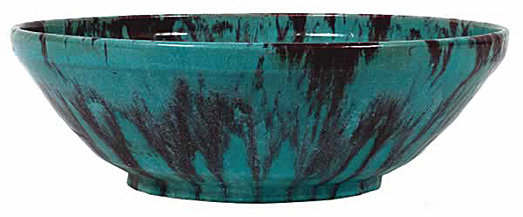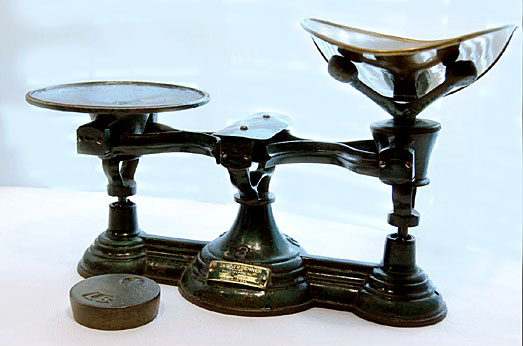 QUESTION: A few years ago, I found several Pewabic ceramic tiles while browsing a local thrift shop. I’m not sure how old they are, but I suspect they’re newer ones, purchased as souvenirs of a visit to the Pewabic Pottery in Detroit. Since the tiles were very attractive, I bought them. However, I don’t know anything about Pewabic tiles. Recently, a friend told me they were by Pewabic. Can you please tell me more about the company? I’d like to buy more of these tiles and possibly start a collection.
QUESTION: A few years ago, I found several Pewabic ceramic tiles while browsing a local thrift shop. I’m not sure how old they are, but I suspect they’re newer ones, purchased as souvenirs of a visit to the Pewabic Pottery in Detroit. Since the tiles were very attractive, I bought them. However, I don’t know anything about Pewabic tiles. Recently, a friend told me they were by Pewabic. Can you please tell me more about the company? I’d like to buy more of these tiles and possibly start a collection.
ANSWER: Pewabic ceramic tiles have been a popular collectible for many years and are relatively easy to find. The pottery is still producing them, including special ceramic Christmas tree ornaments.

 In 1903, Mary Chase Perry Stratton, an artist and educator, and Horace J. Caulkins, a dental supplier and kiln manufacturer founded Pewabic Pottery in Detroit, Michigan, the same year that Henry Ford established his motor company in the city. Caulkins was considered a high-heat and kiln specialist, and developed the "Revelation kiln". Mary Chase Stratton was "the artistic and marketing force." The collaboration of the two and their blend of art and technology gave the pottery its distinctive qualities as Detroit's contribution to the International Arts and Crafts movement and exemplified the American Craftsman Style. The pottery became a leader in the Arts & Crafts Movement for its handcrafted pottery and ceramic tiles.
In 1903, Mary Chase Perry Stratton, an artist and educator, and Horace J. Caulkins, a dental supplier and kiln manufacturer founded Pewabic Pottery in Detroit, Michigan, the same year that Henry Ford established his motor company in the city. Caulkins was considered a high-heat and kiln specialist, and developed the "Revelation kiln". Mary Chase Stratton was "the artistic and marketing force." The collaboration of the two and their blend of art and technology gave the pottery its distinctive qualities as Detroit's contribution to the International Arts and Crafts movement and exemplified the American Craftsman Style. The pottery became a leader in the Arts & Crafts Movement for its handcrafted pottery and ceramic tiles.
 The word Pewabic is derived from the Ojibwa (or Chippewa) word "wabic", which means metal, or "bewabic", which means iron or steel, and specifically referring to the "Pewabic" Upper Peninsula copper mine where Stratton walked with her father. Her workshop was an integral part of America’s Arts and Crafts movement, a backlash against mechanization that began in the late 19th century. In it she fashioned handmade, delicate wares, and was much like Henry Ford’s factory with its assembly-line production.
The word Pewabic is derived from the Ojibwa (or Chippewa) word "wabic", which means metal, or "bewabic", which means iron or steel, and specifically referring to the "Pewabic" Upper Peninsula copper mine where Stratton walked with her father. Her workshop was an integral part of America’s Arts and Crafts movement, a backlash against mechanization that began in the late 19th century. In it she fashioned handmade, delicate wares, and was much like Henry Ford’s factory with its assembly-line production.
 Challenged by a friend to replicate a piece of shimmering Babylonian earthenware, Stratton decided to fire her pieces three times, adding a spray of kerosene for the final blast. The oil burst into flames, combusting with the metal oxides in the glaze to create a swirl of metallic colors. By 1909 she had perfected the iridescent glaze and the process of “fuming” that became the studio’s trademark.
Challenged by a friend to replicate a piece of shimmering Babylonian earthenware, Stratton decided to fire her pieces three times, adding a spray of kerosene for the final blast. The oil burst into flames, combusting with the metal oxides in the glaze to create a swirl of metallic colors. By 1909 she had perfected the iridescent glaze and the process of “fuming” that became the studio’s trademark.
The pottery started out in a carriage house in Detroit’s Brush Park neighborhood (pictured). Quickly outgrowing this “Stable Studio,” renowned architect William Buck Stratton was hired to design the pottery studio on Detroit's East Side, which is still in use today. Production moved into this building in 1907.
 Demand for Pewabic grew thanks to our stunning iridescent glazes and inspiring architectural tile installations throughout southeast Michigan and across the country. Generations have been enriched by the Pewabic art and tile adorning homes, schools, churches, and public institutions, cementing Pewabic into the rich cultural fabric of Detroit.
Demand for Pewabic grew thanks to our stunning iridescent glazes and inspiring architectural tile installations throughout southeast Michigan and across the country. Generations have been enriched by the Pewabic art and tile adorning homes, schools, churches, and public institutions, cementing Pewabic into the rich cultural fabric of Detroit.
 Under Mary Stratton's artistic leadership, Pewabic Pottery employees created lamps, vessels, and architectural tiles. Architectural pieces have been a staple in Pewabic's history. They were known for their iridescent (like an oil slick with an incredible translucent quality and a phantasmagoric depth of color) glazes. Architectural tiles were used in churches, concert halls, fountains, libraries, museums, schools and public buildings. The studio's work graces numerous edifices throughout Michigan and the rest of the United States. Noteworthy examples include Herzstein Hall at Rice University in Houston, Texas, and the Shedd Aquarium in Chicago. Illinois.
Under Mary Stratton's artistic leadership, Pewabic Pottery employees created lamps, vessels, and architectural tiles. Architectural pieces have been a staple in Pewabic's history. They were known for their iridescent (like an oil slick with an incredible translucent quality and a phantasmagoric depth of color) glazes. Architectural tiles were used in churches, concert halls, fountains, libraries, museums, schools and public buildings. The studio's work graces numerous edifices throughout Michigan and the rest of the United States. Noteworthy examples include Herzstein Hall at Rice University in Houston, Texas, and the Shedd Aquarium in Chicago. Illinois.
 Stratton oversaw operation of the pottery until her death at the age of 94. She gifted the pottery to Michigan State University in 1965 which used it for its ceramics education program.
Stratton oversaw operation of the pottery until her death at the age of 94. She gifted the pottery to Michigan State University in 1965 which used it for its ceramics education program.
Pewabic tiles have long been in great demand in Detroit and southeastern Michigan for use in buildings, and they can be found in many of the area's finest structures.
To read more articles on antiques, please visit the Antiques Articles section of my Web site. And to stay up to the minute on antiques and collectibles, please join the over 30,000 readers by following my free online magazine, #TheAntiquesAlmanac. Learn more about "The Vernacular Style" in the 2024 Winter Edition, online now. And to read daily posts about unique objects from the past and their histories, like the #Antiques and More Collection on Facebook.












































